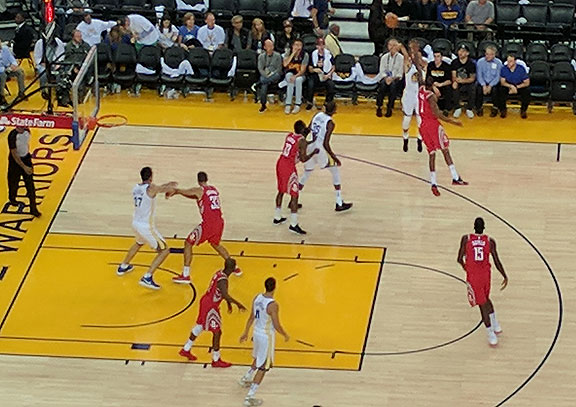
Opening night, Oct. 17, 2017, which the Warriors lost to Houston by 1, but they were champions again by June 2018. Curry has just released a 3-pointer.
We are living the glory days of the Golden State Warriors, going to the NBA Finals for the last four years and winning three of them, setting the single season record of 73-9, changing the nature of the game with their long-range marksmanship, unselfish sharing and dynamic flow, and a sustained defensive excellence. This burst of virtuosity on the basketball court has deep roots even it sometimes feels like it emerged suddenly as if from “nowhere.” There is a fascinating decades-long history in which predominantly African American players invented the physicality and creativity that we enjoy so much among stars like Steph Curry and Kevin Durant. Just as vital to the Warriors success is the extraordinary and infectious defensive talents of Draymond Green, skills based on breakthroughs developed by black roommates at the University of San Francisco in the mid-1950s. The “Strength in Numbers” marketing slogan derives from the Warriors’ actual practice of regularly getting all their players into the game, but has come to exemplify a collective, all-hands-on-deck approach that hints at the horizontalist egalitarian politics of Bay Area political movements, too.
It’s worth remembering that their graceful and scintillating game is itself not such a departure from a longer history of NBA basketball. An early Warriors coach Bill Sharman played for the Boston Celtics in 1959-60, a year when the old-school, defensive-minded Celtics scored an average of 124.5 points per game (without any 3-point line to pad the score). The Warriors led the league in 2016-17 at 115.9 points per game. This is partly because of greater athleticism and more complicated defensive schemes that are used now, but the speedy, pass-oriented offense of the Warriors is itself a throwback to the best years of the early NBA. A couple of decades of superstar-focused, grinding isolation offense finally gave way to the uptempo passing game of this era, and to be sure it all feels new again.
The current Warriors are still a shocking departure from decades of mediocrity and failure for us long-suffering fans. But their stellar qualities—relentless defense, improvisationally brilliant team and individual offense, charismatic and politically outspoken stars—all have long pedigrees rooted in Bay Area, basketball, and sports history. Regular readers may wonder why I am writing about sports at all, given the common antipathy to the fully commodified entertainment industry that harbors pro sports along with music, movies, and everything else in our culture. Long-time sportswriter Robert Lipsyte wrote a seminal book in the mid-1970s called Sportsworld: An American Dreamland in which towards the end he captured my sentiment perfectly: “The joy of sport is as real and accessible as the joy of sex; and both have been distorted and commercialized to make us consume and conform.” This reading and presentation of a particular line through history is meant to undergird my ongoing joy and fascination, but also to reinforce the reality that there is much more to this than simply “buying in” to the hype. Similar to how we can give some of Hollywood’s worst output meanings that weren’t necessarily intended or planned for, we can reappropriate and redefine the meaning of our engagement with sports, athletes, and the political world they increasingly intersect.
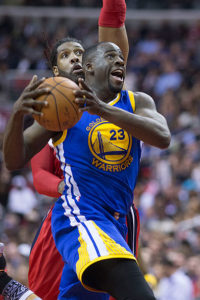
Draymond Green, the defensive soul of the Warriors… very disappointed when he let himself be used for an Israeli Defense Force photo-op in summer 2018.
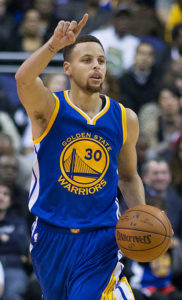
Steph Curry, the two-time MVP and perhaps the best long-range shooter in the history of the game.
A necessary prologue to our story is to acknowledge the earliest black basketball pioneers. Harlem’s Alpha Physical Culture Club sponsored the first Black Five, who played in New York City from 1904-1923 against other “black fives” from other athletic clubs in that era. Interestingly, the commitment to early basketball developed among West Indian immigrants in New York who brought the rigidly conservative philosophy of Caribbean sporting culture they’d learned in childhood. Building on the skills developed during these formative years, the New York Harlem Renaissance Big Five, aka the New York Rens, became the best known team of black basketball players, while other teams proliferated by the late 1930s too: Chicago Crusaders, Ciralsky Meat Packers, Philadelphia Tribunes, Cleveland Pennzoils, Chicago Studebakers, Harlem Globetrotters, Washington Bears, and others. After the Rens won the first World Professional Basketball Tournament in 1939 in New York, and the Globetrotters won the subsequent championship in 1940, it belied any claims to superior skills by white players a decade before the formal integration of professional basketball began.
The NBA’s first black players hit the court in 1950, during the second season of the newly formed league, just four years after Jackie Robinson joined baseball’s Brooklyn Dodgers to break segregation in Major League Baseball. Earl Lloyd, Chuck Cooper, and Sweetwater Clifton all played blue-collar roles—rebounding and defending—that first year. During the 1950s, a steady trickle of black players entered the league, but it wasn’t until the arrival of Bill Russell with the Boston Celtics in 1956-57 and Elgin Baylor with the Minneapolis Lakers in 1958 that the boundaries of the game itself noticeably began to shift. We’ll pick up this part of the story in a bit, but first let’s fill in the story that shaped the Bay Area’s love of basketball, gave it an outsized role in the desegregation of the sport, and an even larger role in the long-term revolt of black athletes against the exploitative conditions they were forced to labor under before unionization and free agency.
The NBA’s first African-American all-star was Oakland’s own Don Barksdale, who only played four seasons before injuries ended his career after the 1954-55 season. Barksdale, a Berkeley native, while a boy during the 1930s attended meetings of his father’s union—the Brotherhood of Sleeping Car Porters—and was strongly influenced by its leaders, A. Philip Randolph and C.L. Dellums. A lanky forward, his best years were during and after WWII when he played for the Amateur Athletic Union (AAU)’s Oakland Bittners. He was also a star on the 1948 Olympic team, where during an intrasquad exhibition match on the University of Kentucky campus in Lexington, he broke the Jim Crow color line during a time-out. (The practice match was held to raise money for the Olympic team, but famously racist Kentucky coach Adolph Rupp tried to ban Barksdale from playing. When Barksdale’s coach and teammates threatened to cancel the game, and lose all that important revenue, Rupp grudgingly relented.)
As told by Ron Thomas in his groundbreaking book They Cleared the Lane: The NBA’s Black Pioneers, the Olympic intrasquad game was finally held before 14,000 fans on an outdoor field. During the game, eventually won by Barksdale’s side after a great performance by him, a timeout hushed the fans. A water bucket was brought to the players and a bottle was passed around each huddle. In Lexington, Kentucky in 1948 there was strict segregation including water fountains. When the bottle came to Barksdale he almost turned away but went ahead and had his drink. He passed the bottle on to a gangly white guy from Arkansas who took the bottle and had his drink, rather than tossing the bottle away and reinforcing the Jim Crow rules. The entire audience had been raucous, then dead silent while this took place, and then resumed chattering afterwards, as small actions such as this were still achingly important in those apartheid-like times. A pre-game death threat led to Barksdale fearing for his life during and after the game.
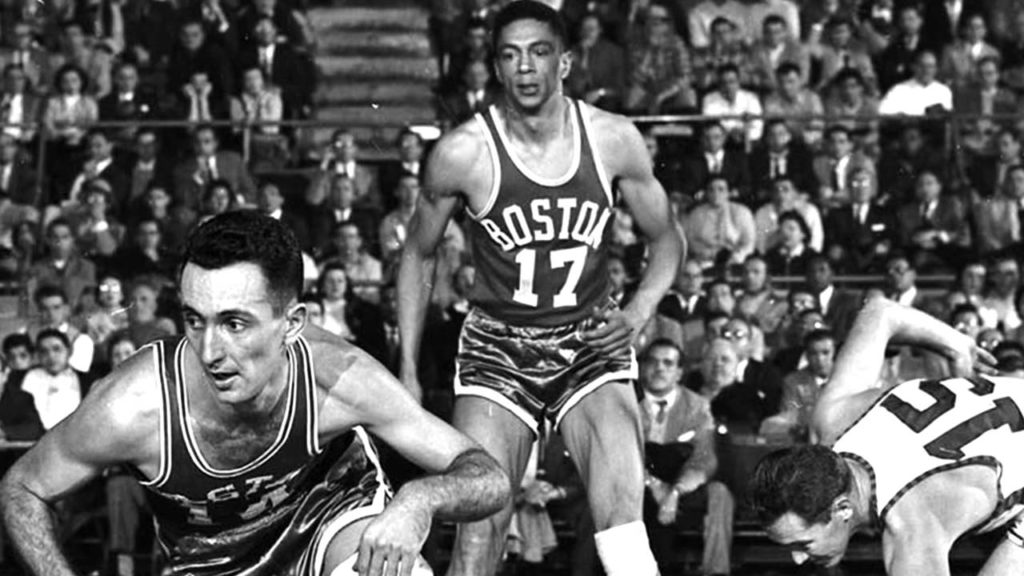
Berkeley’s Don Barksdale, the first African American all-star in the NBA.
A year later, back in the Bay Area, a different kind of transgression took place as a commercial venture staged by Frank “Bow Tie” Walsh, a man who “could sell a refrigerator at the North Pole,” according to his wife. Walsh discovered San Francisco’s then-new Cow Palace as a great place to host basketball in 1947, and by 1949 saw a great opportunity. Walsh was friends with Abe Saperstein, the owner of the Harlem Globetrotters (a man who thought he had a proprietary right to all black basketball talent—early NBA owners were afraid to buck him since they depended on doubleheaders with the popular Globetrotters to fill the arenas in a time of low attendance), and thus was very aware of the talent in black college basketball. Knowing that the pre-eminent national tournament then (the NIT) refused to allow black college teams, Walsh invited the best black college team in the nation, West Virginia State College, to play against several of the best teams on the West Coast.
The St. Mary’s Gaels defeated the West Virginia State College Yellow Jackets at the Cow Palace during that first-ever match between a white and black team on the West Coast. It was headline news in the San Francisco Chronicle’s sports pages. Local sports coverage in that era gave as much or more attention to college as professional sports. The professional teams that became the NBA in 1949 were all clustered in the east from Washington to Boston, and from Detroit to St. Louis in the midwest, but the sport was barely a blip in national consciousness. The USF Dons won the NIT in 1949 before a point-shaving scandal tarnished the tournament in 1950. As the NCAA rose to prominence, Bay Area fans were primed for another local team to make a national splash. When the USF Dons became a national power in the 1954-55 season, the entire Bay Area, no more than a quarter of its current size, rallied behind the team, having already watched the new phenom, center Bill Russell, dominate his opponents during his freshman and sophomore years.
Bill Russell was born in Louisiana and moved to the Bay Area as a 9-year-old, landing in Oakland. After a relatively undistinguished high school career at West Oakland’s McClymonds High School his growing height and jumping ability attracted USF coach Phil Woolpert’s attention and he was offered a scholarship. (Incredibly, while Russell played basketball at McClymonds, future baseball stars Frank Robinson, Vada Pinson, and Curt Flood all played outfield there. Two of them would be vital contributors to advancing desegregation and the rights of all athletes in the years ahead: Frank Robinson eventually became the first black manager in baseball in 1975 after a Hall of Fame career, and Curt Flood’s refusal of a trade in 1969 led to a US Supreme Court challenge to the “reserve clause” that kept players under the control of teams for life irrespective of contracts; though Flood lost his case, his challenge is recognized as a vital blow to the system that soon unraveled and led to free agency in baseball and other pro sports.)
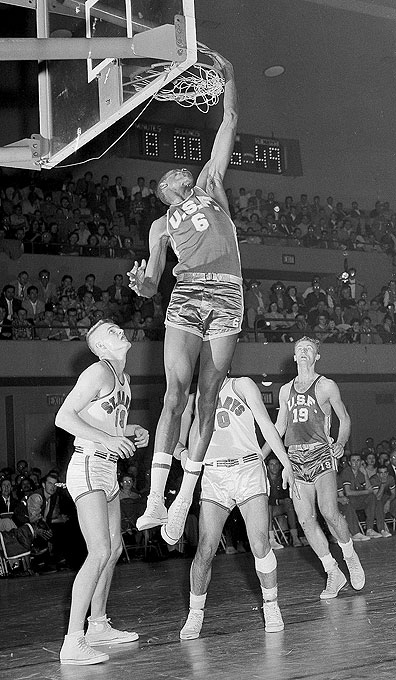
Bill Russell, leaping high above the rim, the talent which helped him redefine the game of basketball.
Bill Russell entered USF and soon met his new dormie, a young man from Commerce High School in San Francisco, K.C. Jones. Russell and Jones became friends who spent countless late nights in the gym working on their game with assistant coach Ross Guidice, and when in their dorm, discussing strategy and basketball tactics late into the night. Together they developed a geometric analysis of basketball, dissecting its horizontal and vertical planes along points, lines, and angles. With this analytical acuity, the two of them developed an unprecedented approach to the defensive side of basketball. It could be argued that they invented the key concepts of defensive basketball, Russell providing a leaping intimidating rim protection while Jones excelled at a swarming aggressive perimeter defense, essential precursors to the Warriors’ smothering switching defenses during their recent championship seasons. During USF’s 60-game winning streak and back-to-back NCAA national championships in 1954-55 and 1955-56, they also invented the “alley-oop,” a play commonly used ever since, and central to today’s Golden State Warriors use of their many different centers. The original alley-oop was used so heavily by Russell and his teammates that college basketball had to outlaw “offensive goaltending” since USF was often having its players throw the ball up towards the basket to give Russell, the amazing leaper, the chance to catch the ball near the cylinder and drop it into the net. Another rule change to combat Russell’s skills had little effect on his dominance: the expansion of the “key” from 6 feet to 12 feet, in order to prevent big men from camping under the basket. Given his agility and speed, he continued to dominate his slower and heavier opponents.
The fact that two young black college students were inventing a new way to play basketball, and their combo eventually dominated the NBA for an unmatched run of 13 championships with the storied Boston Celtics, is already remarkable on its face. But remember this is the mid-1950s. Just before their two-year run into the ranks of legendary college powerhouses, the Supreme Court handed down its Brown v. Board of Education decision in 1954, mandating the desegregation of public schools. Desegregation of housing and employment were still years off, and the violent resistance to school desegregation would plague the U.S. for the next decades too. Jim Crow segregation was the law of the land throughout the South, and even in liberal San Francisco, harsh discrimination against African Americans was the norm, albeit without the formal separation of restrooms, water fountains, etc. In this oppressive and stodgy 1950s America, also dominated by anti-communist hysteria, the players faced harassment and discrimination both overtly and implicitly. Their coach, Phil Woolpert, was badgered incessantly by USF alumni not to play more than 2, then 3, black players at a time. Scholarships for black players were considered misplaced since they may have been used for deserving white players. Fortunately Woolpert was an early and vociferous anti-racist and rejected all pressure on this front. When USF lost an early season 1954 game to UCLA, Coach Woolpert, who had been regularly warned by alumni and other coaches about starting three black players, cast those concerns aside. After Woolpert decided to play his best five players regardless of skin color, USF became an overwhelmingly dominant basketball power.
As they rolled off victory after victory, the players came together as a cohesive team. Playing and traveling together, they didn’t socialize much off the court. The African American players would frequent the nearby Fillmore district, a vibrant center of black culture in the 1950s. Bill Russell discovered the coffeehouses of North Beach, and enjoyed the beat scene at the Hungry I and other haunts, taking in satirist Mort Sahl, left-wing balladeer Pete Seeger, and the legendary Josh White. Russell describes his college meanderings: “Those coffee houses opened up a new way of thinking for me, because I saw that at least some white people got the blues, were irreverent, and weren’t tight-assed. Most of the white folks at USF walked like moving fence posts, while the beatniks looked more like sloping question marks.”

After the 2nd consecutive NCAA championship in 1956, Russell is carried off the court by jubilant fans.
On their way to the national championship, USF dominated Stanford at a game played in January 1955 at the Cow Palace. Stanford coach Howie Dallmar said after the game that his team had used three different defenses against USF: the zone, man-to-man, and panic! For two years, from December, 1954 to December, 1956, the USF Dons went undefeated. It is easy to see the extraordinary talent and creative new approach of Russell and Jones as the key to this domination, but lost in this remarkable run is the shock and fear the players had to endure when they went to New Orleans to play Loyola of the South in December 1955.
Russell had spent his early childhood in rural Louisiana and his father, who lived much of his life in the Jim Crow South, was a strong presence in his life, so he was surely more prepared than his teammates to find “white” and “colored” water fountains and restrooms in the New Orleans airport. Hal Perry had grown up in Ukiah in a white community, guard Gene Brown had starred for Washington High in San Francisco’s Richmond District, and K.C. Jones of course had been a star for Commerce High and lived in Hunter’s Point—none of them had ever seen the South in person. Refused service at their hotel, the black players found lodging at Xavier University (along with two of their white teammates who surreptitiously joined them in solidarity), but during their time in the area they were forced to use segregated restrooms, restaurants, and public transportation. Loyola of the South was a small Jesuit university and had quickly moved to integrate its athletic programs after Brown v. Board of Education, unlike other local schools. But when the USF players arrived it was just weeks after the one-day bus boycott in Montgomery, Alabama, sparked by the arrest of Rosa Parks. It was only four months since 14-year-old Emmett Till had been killed in a grisly public lynching. Racist tension was palpable; in a prior stop in Wichita, Kansas, white fans had booed Russell and Jones every time they went to the free throw line, and cheered when they left the game after dispatching their opponents. The team finished their southern tour without further incident, but the repressive racial atmosphere of the 1950s weighed on all black players wherever they played.

The Lakers’ legendary forward Elgin Baylor, seen here playing against the Warriors in the early 1960s in the San Francisco Civic Auditorium.
Elgin Baylor, who had grown up playing in the schoolyards of Washington D.C., starred in college for Seattle University. Holding a one-point lead in the NCAA Western Regionals in 1958 at the Cow Palace against the favored USF Dons, with ten seconds left, Elgin Baylor dribbled over half court and calmly drained a 30-foot shot to guarantee Seattle the victory (this was before the 3-point shot was added to the game). Baylor took the game by storm and introduced a variety of offensive techniques no one had ever seen before. His schoolyard years had taught him a wide range of one-on-one moves, body control, playmaking ability, and gave him an uncanny ability to change pace, change his dribble, change hands in mid-air—things we have come to take for granted in our era with so many amazing players, but were brand new when Baylor came along. At 6’5” and 220 pounds he was an unusually large ball handler and most famous for his ability to twist and hang in mid-air before sinking his acrobatic shots. As Bijan Bayne, his biographer, describes him: “the yo-yo dribbling, the subtle feints, the knifing reverse layups between taller defenders… set Baylor apart from his predecessors and peers. Baylor scored on one-hand push shots, banks, floaters, and fallaways… Seattle sportswriter Emmet Watson famously quipped: ‘He has never really broken the law of gravity, but he is awfully slow about obeying it.’” Sportswriter Jack McCallum quotes Warrior legend Rick Barry: “Baylor was the guy who changed the game as far as athleticism went… Jump, do all kinds of things in the air. It was Baylor. No one else.” McCallum argues that it was Baylor who brought poetic hyperbole into the sport, and that he was “free-form jazz, improvisational.”
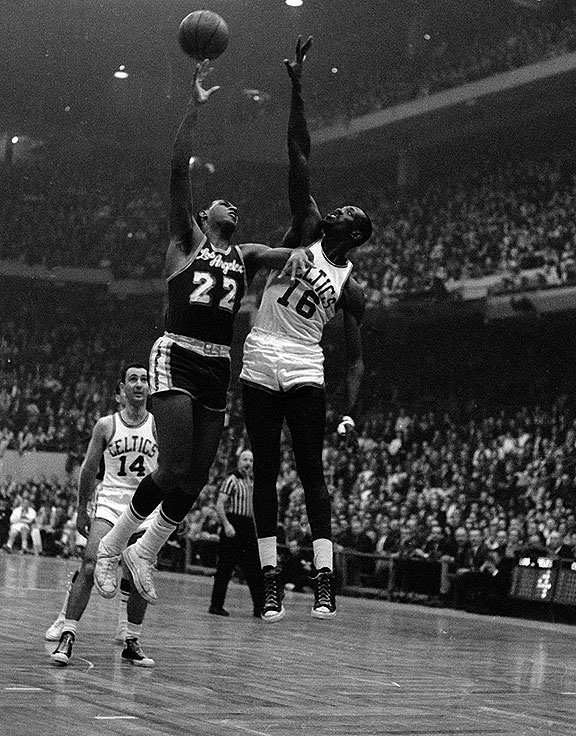
Elgin Baylor at his peak, going up against the rival Boston Celtics.
In January 1959, Baylor’s Minneapolis Lakers were in Charleston, West Virginia for a game against the Cincinnati Royals. When they tried to check in to their hotel, the desk clerk wouldn’t accept “the colored fellas” (Baylor and his two African American teammates). Eventually the team checked into a black-friendly retirement hotel. Bad enough, but when no place in town would serve a meal to Baylor, Ellis or Fleming, Baylor decided to skip that evening’s game, saying “I’m no dog.” It wasn’t easy but he sat courtside while the Lakers lost to the Royals by four, and two years later on a return visit to Charleston the local NAACP honored him for helping to break down the Jim Crow culture in the city. Two years and 175 miles to the west, Bill Russell and the rest of the black players on both the Boston Celtics and St. Louis Hawks refused to play a game in Lexington, Kentucky after being refused service at local restaurant in 1961. Lexington, Kentucky was the same town in which Don Barksdale had shared water with white teammates during the 1948 pre-Olympic contest, and the home of legendarily racist college basketball coach Adolph Rupp. (An epic confrontation in the 1966 NCAA Finals saw his all-white Kentucky Wildcats lose to the first team starting five African Americans to make it to the Finals, the Texas Western Miners. It should also be noted that historically black colleges weren’t allowed to play in the NCAAs until 1970!)
In 1960, on the same day that four black students began a sit-in against a segregated lunch counter at a Woolworth’s in Greensboro, North Carolina, the first pro basketball game at the Los Angeles Sport Arena was played between the new Los Angeles Lakers starring Elgin Baylor and the Philadelphia Warriors starring rookie Wilt Chamberlain. The Lakers, with Baylor as the first emerging superstar in the NBA, quickly won Los Angeles’ affection. Attendance outstripped the rest of the league, and basketball quickly became hugely popular around southern California. In the wake of the Lakers’ arrival, UCLA soon became a college basketball powerhouse, winning their first national NCAA title in 1964 and again in 1965. This virtuous cycle of success helped UCLA recruit the young New York high school phenom Lew Alcindor (now better known as Kareem Abdul-Jabbar) who led the program to several more national titles. (Alcindor himself became an icon of the late 1960s movements when he refused to play in the 1968 Mexico City Olympics in protest of the Vietnam War and in solidarity with the urban unrest of the era.)

Lew Alcindor, playing here for UCLA, later changed his name to Kareem Abdul-Jabbar, and still holds the record for the most NBA games ever played.
With the new celebrity of Los Angeles basketball, attendance kept growing and television contracts began to be inked. In February 1964, the NBA All-Star game was about to be played on live television for the first time ever. The players, aggrieved over any number of issues, decided to make a stand in favor of a guaranteed pension to be paid by the owners. They held back in the locker room and told the owners that they would not play unless they received a guarantee that a new pension plan would be funded. The owners were livid but after some ventilating, gave in to the players’ demand and the game went on, about 15 minutes late. All-star point guard Oscar Robertson of the Cincinnati Royals and the Celtics’ Tommy Heinsohn led the successful revolt.
Oscar Robertson’s contribution to the NBA extended far beyond the playing court when he succeeded Tom Heinsohn as president of the NBA Players Association in 1966. Under Robertson’s leadership the “Oscar Robertson suit” was filed to block a merger with the American Basketball Association until favorable conditions could be agreed upon. Eventually the 1976 Oscar Robertson Settlement Agreement approved the college draft as the initial way of dispensing players. It also laid the foundation for the free agent system which has brought countless riches to players and resulted in the NBA’s merger with the ABA in 1976. (Thomas: 2004)
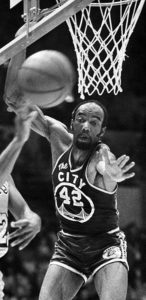
Nate Thurmond, one of the best players ever in a Warriors uniform.
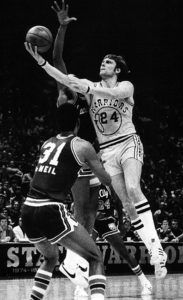
Rick Barry, the best pure shooting Warrior until Steph Curry came along.
The Warriors moved to San Francisco in 1962-63, expecting a huge welcome for their incredible star Wilt Chamberlain. They played their first game at the Cow Palace on October 23, 1962, just a week after Willie McCovey’s screaming line drive in Game 7 in the bottom of the 9th with two outs disappeared into leaping Bobby Richardson’s glove at 2nd base, instead of clearing the bases and winning the World Series for the Giants against the Yankees. But Bay Area fans yawned, and attendance averaged less than 5,000 that first season at the Cow Palace. Several subsequent years were played at the 1915 Civic Auditorium near City Hall where small crowds enjoying the throwback intimacy rarely filled the old hall. The year before moving to San Francisco from Philadelphia, Chamberlain had scored 100 points in a game, a feat never matched again, though only 4,000-odd fans saw it during the game in Hershey, Pennsylvania. On the West Coast, the Warriors fielded a dynamic backcourt of Guy Rodgers and Al Attles to go with Wilt the Stilt, backup center Nate Thurmond, and power forward Tom Meschery. The Warriors went to the NBA finals in 1964 only to lose to the Bill Russell/KC Jones Celtics 4 games to 1. After a couple of bad years, they traded away Wilt Chamberlain to the Philadelphia 76ers and promoted Nate Thurmond to starting center. With the addition of scoring star forward Rick Barry, the Warriors once again won the Western Conference and made it to the Finals in 1967, only to lose to Wilt and the 76ers 4-2.
Al Attles spent decades in the Warriors organization, starting in 1960 as a rookie point guard, and eventually becoming the 2nd black player-coach in the league after Bill Russell in Boston. Famously tough, Attles never really expected to make the NBA but once he did he ran into the discrimination that was still the norm in 1960. After he won his spot he heard that one of the Warriors’ returning black players, Woody Sauldsberry, had been traded to St. Louis. The tacit quota system held that no NBA team should have more than four black players on the roster. Legendary Bay Area sports announcer (and voice of the Warriors for a generation) Bill King remembered that when Boston’s Red Auerbach started five black players for the first time in 1965 it was a big deal and subject to much tut-tutting around the league.
By the late 1960s, more than 50% of the NBA was African American. Some posit that this is why the league failed to develop a mass audience, falling behind the other major sports. A 1975 survey by Newsday showed that in 14 of 20 American cities that had both pro hockey and pro basketball franchises, the hockey team outdrew the basketball team, sometimes even if the hockey team had a losing record and the basketball team was winning. The NBA had enjoyed a huge surge of interest when the New York Knicks defeated the Los Angeles Lakers in an epic 7-game Finals in 1970. The following year veteran Oscar Robertson was traded to the Milwaukee Bucks, already home to the budding superstar Kareem Abdul-Jabbar, and together with a healthy supporting cast they won the championship in 1971. But as Lipsyte puts it, the much-hyped Knicks’ “dynasty” was over before it reproduced, and so was the so-called “Sport of the Seventies.”
The national media had given basketball a boost that would keep it running at high speed for a few years, but they didn’t stay for the ride. Basketball was too black. First of all, it was too black for the sportwriters. White males who had never understood Russell or Chamberlain or Hawkins or Abdul-Jabbar as individuals were suddenly faced with the first major sport in which they felt racially outnumbered and culturally alienated. There were black coaches, black general managers, rumors of a black commissioner. Two-thirds of the players were black. Sportwriters began floating the self-fulfilling prophecy that basketball had peaked because most fans were basically too racist to accept black heroes for their children. (Lipsyte: 1975)
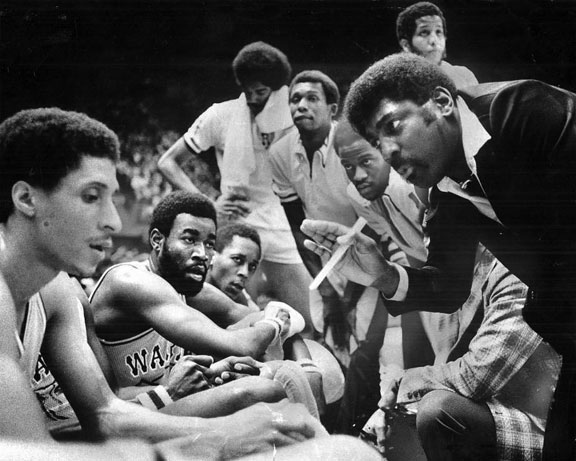
Al Attles confers with Phil Smith and his Warriors teammates in 1976.
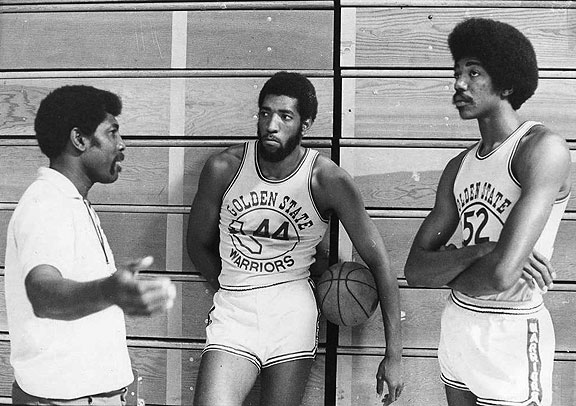
Attles conferring with his two centers Clifford Ray and George Lee, both defensive specialists.
Even though interest in the NBA plateaued, the Golden State Warriors, playing in Oakland from 1971, were on the upswing. Thriving under player-coach Al Attles, the team gelled around the return of Rick Barry from his time in the upstart ABA. With defensive brilliance from Larry Smith and Cliff Ray, and lights-out shooting from Barry and Jamal Wilkes, the Warriors made their way through the playoffs in 1975 and as heavy underdogs upset the Washington Bullets in a shocking sweep of the Finals. Attles extended Celtic’s long-time coach Red Auerbach’s concept of the “Sixth Man” and applied it to nearly his entire bench. As Steve Kerr would reproduce in our current era, Attles led the Warriors to an NBA championship by using an 11-player rotation, spreading the playing time around and focusing on a team approach. Attles, like Kerr today, believed that players need to have regular playing time to maintain motivation and to know what to do in real games with real consequences.
After the unexpected and exciting championship in the 1974-75 season the Warriors failed to repeat. Within a few years they were languishing near the bottom of the standings and a very long period of bad basketball ensued. Meanwhile, the NBA itself hit the jackpot in 1979-1980 when nationally famous rookies Magic Johnson (Michigan State) and Larry Bird (Indiana State) brought their already legendary rivalry to the NBA (Johnson to the Lakers and Bird to the Celtics). The doldrums of the 1970s, in which advertisers preferred college basketball to the NBA, ostensibly because the NBA was too black, finally began to ease up. In their first season the rejuvenated Lakers made the NBA finals, where Magic Johnson filled in at center for the injured Kareem Abdul-Jabbar in Game 6, scoring 42 points, 15 rebounds and 7 assists in the final victory. Tellingly, the decisive game was only televised on a tape delay. As late as 1985, only five NBA games had prime-time slots. The NBA was already awash in talent when Michael Jordan hit the league in 1984, but he took the league by storm and drove the Chicago Bulls to six championships while becoming the advertising icon of the century.
The 1980s was also a decade in which basketball stars went silent. The “Heritage,” a politicized engagement with the larger world that was rooted in baseball’s Jackie Robinson and other early African American players, boxing’s Muhammad Ali, football’s Jim Brown, basketball’s Bill Russell, Oscar Robertson, and Kareem Abdul-Jabbar, was in abeyance. OJ Simpson had parlayed his fame and talent into becoming an advertising pitchman for Avis and other corporations in the 1970s, carefully avoiding any expression of political awareness (he was famously quoted as saying “I’m not black, I’m OJ). Michael Jordan followed that path and enlarged it considerably in becoming the universal pitchman of the late 20th century, so much so that his own teammate Craig Hodges called him out in 1992 after the Rodney King riots in Los Angeles. When the riots exploded at the end of April 1992, the Bulls were finishing their first-round sweep of the Miami Heat. Neither Jordan nor the Lakers’ Magic Johnson would entertain Hodges’ proposal to boycott the Finals games to protest the exoneration of the police for beating Rodney King. Craig Hodges went to George H.W. Bush’s White House later as part of the Bulls’ championship visit in a dashiki and delivered a handwritten letter to the president decrying the structural racism in the U.S. and calling for change. Hodges never played again. As a talented outside shooting free agent he might have expected some offers but none came. He had called out Michael Jordan for not doing enough for black people and tried to unite the players to use their power to take action. Both were unacceptable.
In 1991, an incoming cohort of spectacularly talented basketball players hit the University of Michigan with a bang. The “Fab Five” included Chris Webber, Jalen Rose, Juwan Howard, Jimmy King, and Ray Jackson, and quickly they reached celebrity status. Juwan Howard describes the experience to Etan Thomas:
Nike would send us a ton of shoes and apparel for us to wear on the court … They wanted their brand to specifically be associated with the University of Michigan. So we began to realize that this was a huge financial gain for the university and for the Nike company, but we weren’t really benefiting from it. [We] all barely had any money in our pockets to do anything. We were noticing our jerseys being sold everywhere in the state… And we would see the same thing when we traveled outside of the state of Michigan. We had become this global phenomenon, but we weren’t seeing any money from it. (Thomas: 2018)
In protest, these college freshmen boycotted their own jerseys and wore black socks and distinctive hair cuts, for which they were deluged with racist backlash. The efforts by college athletes to achieve some financial independence has been long and, so far, unsuccessful, though every year the clamor for justice rises a bit louder, even while recruiting and bribery scandals continue to beset major college programs every year. The USF Dons actually suspended their Division 1 basketball program in 1982 after repeated violations of the NCAA rules that prevent alumni from offering financial support directly to recruiting efforts or to players.
In 2014 writing in Time magazine retired star Kareem Abdul-Jabbar wrote: “Fair play, sportsmanship, and good-natured rivalry are lofty goals to live by. By treating the athletes like indentured servants, we’re tarnishing that symbol and reducing college sports to just another exploitation of workers, no better than a sweatshop.” He went on to cite the mind-boggling financial statistics showing that college sports is a $6-billion-a-year industry, with $1 billion being generated just from the annual NCAA basketball tournament now billed as “March Madness.” The top ten NCAA basketball coaches earn salaries from $2.2-9.7 million PER YEAR! Taylor Branch, brilliant historian of the Civil Rights movement and co-writer of Bill Russell’s autobiography Second Wind lays it bare: “For all the outrage, the real scandal is . . . that two of the noble principles on which the NCAA justifies its existence–‘amateurism’ and the ‘student-athlete’–are cynical hoaxes, legalistic confections propagated by the universities so they can exploit the skills and fame of young athletes.”
With college basketball as the necessary door through which nearly all NBA players must pass, the lessons learned by this exploitation are lost on no one.
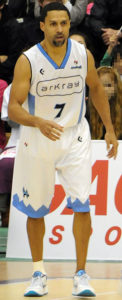
Mahmoud Abdul-Rauf, playing here for a Turkish team after leaving the NBA.
Through the years, isolated protests didn’t cohere into a collective approach to the larger society by NBA players. Olden Polynice led a three-week hunger strike in 1993 to support the 2,230 Haitiian refugees who had been detained at Guantanamo by the Clinton regime. Mahmoud Abdul-Rauf refused to stand during the national anthem while playing for the Denver Nuggets in 1996, leading to his suspension by the NBA. Protesting the flag as a symbol of oppression and U.S. tyranny, his act remained isolated. An explosive scorer who once drained 51 points in a game, he negotiated reinstatement but by 1998 had signed overseas. Etan Thomas of the Washington Wizards became a prominent anti-war speaker during the 2003 run-up to the invasion of Iraq, and though he was given warm support by his team’s owner and CEO, other NBA players for the most part remained silent.
For all the recent controversy about the National Anthem, few have looked back to see how it came to be that we have the anthem ritual before every professional sports event. It was started during WWI by the owner of the New York Yankees baseball team, partly to distract fans from his own German heritage, and partly to justify “playing a game” during war-time. With Colin Kaepernick’s kneeling protest, the Trumpian racists have worked overtime to recast the protest as being against the country, the flag, and the military, in sharp distinction to the stated intentions of Kaepernick and other NFL protesters.
The forced and exaggerated patriotism at the front of professional sports games (especially the NFL) turns out to be have been largely a paid propaganda campaign by the U.S. military. In their 2015 Senate report Tackling Paid Patriotism, Arizona senators McCain and Flake unmasked the fake rituals that disgrace pro sports. Sports teams had charged the military at least $6.8 million (and counting) to stage events at ballparks, leaving veterans bitter and feeling used. But as Howard Bryant sharply notes, the public didn’t care.
The selling of patriotism, of healing the wound of 9/11, of participating in something that felt unifying, even it was inauthentic and bred an encroaching authoritarianism, was more important than the effects of war… The more soldiers became a part of everyday life—at the airport, the train station, Times Square, the Pantheon, or any world landmark that was a target for attack—the less you heard the word war. It was a word scrubbed from whatever limited national conversation was taking place. Post-9/11 America killed the neutral sporting event, but it also killed the traditional antiwar movement. American didn’t even feel as if it was at war, and when soldiers were trotted out to the pitcher’s mound—the wounded, the maimed, the broken by PTSD—the public never reconnected them to the trauma and to the politics that had maimed and broken them in the first place. That part disappeared.
The most recent turning point came in the wake of the brutal 2012 murder of Trayvon Martin in Florida by self-appointed neighborhood vigilante George Zimmerman. LeBron James and his Miami Heat teammates wore hoodies on court during warm-ups in solidarity with Martin whose hoodie was blamed for his victimization since it supposedly made him look like a criminal. Eric Garner was killed by New York police when they choked him to death after arresting him for selling individual cigarettes on the street. Disgusted by the video of the murder, Derek Rose of the Chicago Bulls wore an “I Can’t Breathe” t-shirt, and was soon copied by the Heat players and others around the NBA. As the Black Lives Matter protests expanded, players became more outspoken.

Brooklyn Nets don “I Can’t Breathe” t-shirts to protest the murder of Eric Garner by NY Police.
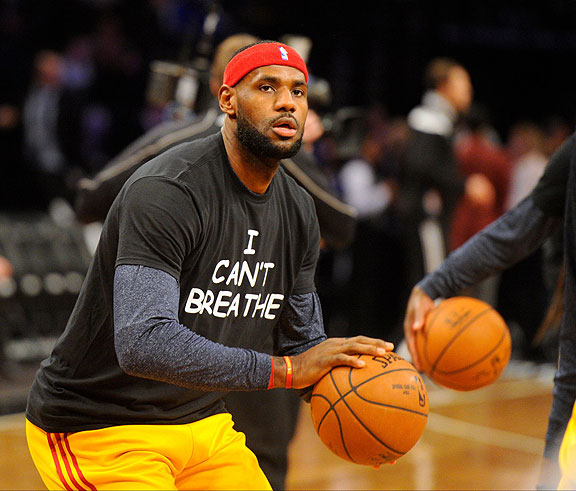
LeBron wore one too… When he was on the Miami Heat, he and his teammates wore hoodies to protest Trayvon Martin’s murder at the hands of vigilante George Zimmerman.
Los Angeles Clippers players were confronted by the leak of team owner Donald Sterling’s racist rants just as they were in the middle of the 2014 playoffs. (For years Elgin Baylor had served as General Manager for Sterling and when he left the team several years earlier he had filed a discrimination lawsuit against Sterling, alleging both racial and age discrimination. Unfortunately Baylor lost his suit.) Clippers players decided not to boycott the playoffs but wore their warm-up jerseys inside out and dumped them unceremoniously at mid-court in a pre-game protest. Universal condemnation rained down on Sterling and four days later NBA Commissioner Adam Silver banned Sterling for life and fined him the maximum $2.5 million. Before the following season the team was sold to Microsoft’s Steve Ballmer.
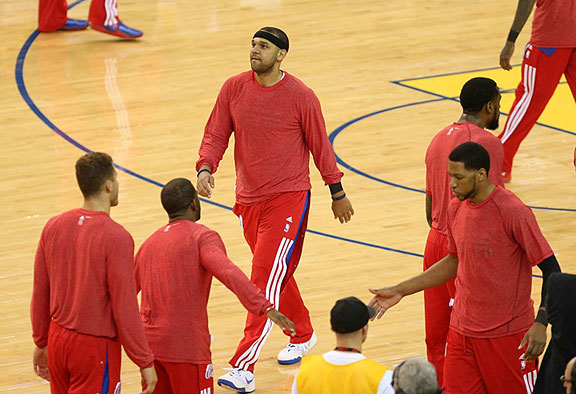
Clippers warming up in 2014 playoff game with their jerseys inside out.
Atlanta Hawks player Thabo Sefolosha was assaulted by New York police in April 2015 during the playoffs. Ignored by the sports media, Sefolosha had been at a nightclub and on departure was filmed as the police attacked him, breaking his leg. Strangely, neither the media nor the players raised the profile of this blatant injustice. Thanks to the video of the incident, attempts by the police to frame Sefolosha and claim he had threatened or attacked police were disproven.
The Warriors made a splash as a team when the won the NBA championship for the 2nd time and immediately announced they would not make the customary trip to the White House under Donald Trump (which they HAD made under Obama in 2015). Trump of course rushed to say that they weren’t invited in the first place, but the point was made. Steph Curry publicly contradicted the CEO of UnderArmour after the latter said Trump was an “asset” and Curry agreed as long as you removed the ‘et’. Coach Steve Kerr has been one of the most outspoken critics of Trump and the racist politics he’s promoted. David West, Andre Iguodala, Draymond Green, Shaun Livingston, and Kevin Durant have all spoken out too, giving the Warriors a certain cachet as a team of independent and intelligent players.
That said, no NBA team or player comes close to the political acumen and outspokenness shown by the women of the WNBA. Dave Zirin captures it well in his afterword to Etan Thomas’s book:
Demolishing competition for the most “woke” league right now has to be the WNBA, led by former star Swin Cash and the New York Liberty, with their orchestrated media blackout in which they discussed only Black Lives Matter and police killings in postgame interviews. In September 2016, in her final game as a pro, Tamika Catchings and the entire Indiana Fever team took a knee during the national anthem before a playoff game. Black women have historically been a lynchpin of social movements, so it’s no surprise that the WNBA, with its 69 percent Black majority, would lead the way on these critical issues.
We enjoy the Warriors more for their play than their politics, though knowing that they have some politics makes enjoying their play a lot easier than if they were pro-war zealots. The team’s culture has percolated back and forth with the Bay Area and national fan base, promoting autonomous outspokenness over conformist complicity, while openly embracing joy and pleasure as greater existential motivations than sacrifice and suffering. Somehow the Golden State Warriors have become visible markers of a cultural and political current that starkly repudiates the venal racism, misogyny, and homophobia that not only are riding high on Trump’s coattails, but have long been the foundation of American society. (Team President Rick Welts is the rare “out” gay executive in professional sports. Curry recently held a press conference on behalf of women’s rights, emphasizing his wife’s accomplishments and the future his daughters face.)
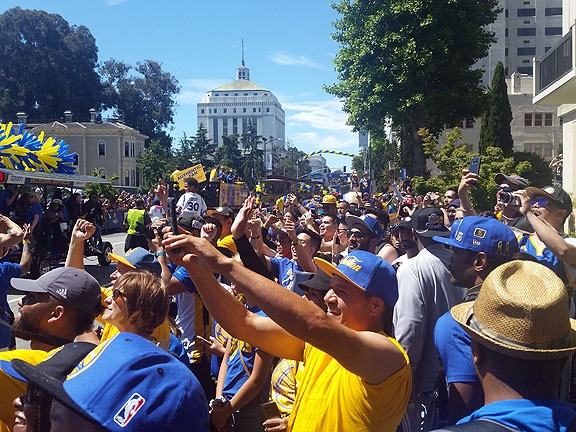
Happy fans jam downtown Oakland to celebrate the Warriors after their 2017 championship, the 2nd of what has so far been 3 out of 4 through 2018.
Basketball is a business, and the players who we love to watch are all millionaires now. The virtuosity that every new generation has brought to the game since the 1950s has raised the bar, the speed, and the talent to incredible heights. From Elgin Baylor and Bill Russell and KC Jones to today’s stars runs a line through dozens of remarkably talented and brilliant, mostly African American players. Together they have changed the nature of how the game is played, while setting a standard of black intelligence and creativity that shapes the culture as a whole. Increasingly, the platform provided by their wealth and acclaim is being used by outspoken players to address the systemic inequities of life in the United States. Will millionaire athletes follow through when the inevitable social upheavals begin? Whose side will they be on then?
Bibliography
Bayne, Bijan C. 2015. Elgin Baylor: The Man Who Changed Basketball Rowman & Littlefield, New York.
Bryant, Howard. 2018. The Heritage: Black Athletes, A Divided America, and the Politics of Patriotism Beacon Press, Boston MA.
Flood, Curt. Wikipedia entry. Accessed October 16, 2018.
Johnson, Claude. 2012. Black Fives: The Alpha Physical Culture Club’s Pioneering African American Basketball Team, 1904-1923 Black Fives Publishing, Greenwich, CT.
Johnson, James W. 2009. The Dandy Dons: Bill Russell, K.C. Jones, Phil Woolpert, and One of College Basketball’s Greatest and Most Innovative Teams University of Nebraska Press.
Korach, Ken. 2013. Holy Toledo, Lessons from Bill King: Renaissance Man of the Mic Wellstone Books
Lipsyte. Robert. 2018 (1975). Sportsworld: An American Dreamland Rutgers University Press
Malinowski, Erik. 2017. BetaBall: How Silicon Valley and Science Built one of the Greatest Basketball Teams in History Atria Books, New York
McCallum, Jack. 2017. Golden Days: West’s Lakers, Steph’s Warriors, and the California Dreamers who Reinvented Basketball Ballantine Books, New York.
Rosen, Charley. 2009. The First Tip-Off: The Incredible Story of the Birth of the NBA McGraw-Hill, New York
Russell, Bill, and Taylor Branch. 1979. Second Wind: The Memoirs of an Opionated Man Random House, New York.
Thomas, Etan. 2018. We Matter: Athletes and Activism Akashic Books, Brooklyn NY
Thomas, Ron. 2004. They Cleared The Lane: The NBA’s Black Pioneers University of Nebraska Press
P.S.
Ode to The Warriors Girls
by Chris Carlsson, 1994
Warriors Girls
sure ain’t wimmin
Shiny blue leotards
comely physiques
Big Hair
after halftime
black spandex hotpants
Laundry List-ism
cheerleader style:
2 blondes
3 asian-americans
1 african-american
2 brunettes
3 latinas
the music
of course
the favorite
of the white upper-middle
class
pro-basketball
clientele:
rap
Warriors Girls
they get down
they dance
they preen
they clap
they throb
rhythmically
tight
choreography
and
clothes
we gaze
glazed
from on
high
row Q
section 217
binoculars?
yes, but,
no
it’s better to see the
whole scene
soulfunkshakin’
goin’on
timeout’s over
p.a.:
“And there are
YOUR WARRIOR GIRLS!!”
Wild bouncing
legs flying to the
ceiling
appreciative waves
carefree jog back to
end
court
play resumes












Leave a Reply